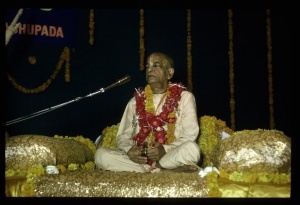CC Madhya 11.165 (1975): Difference between revisions
(Vanibot #0027: CCMirror - Mirror CC's 1996 edition to form a basis for 1975) |
(Vanibot #0020: VersionCompareLinker - added a link to the Version Compare feature) |
||
| Line 2: | Line 2: | ||
<div style="float:left">'''[[Sri Caitanya-caritamrta (1975)|Śrī Caitanya-caritāmṛta (1975)]] - [[CC Madhya (1975)|Madhya-līlā]] - [[CC Madhya 11 (1975)|Chapter 11: The Beḍā-kīrtana Pastimes of Śrī Caitanya Mahāprabhu]]'''</div> | <div style="float:left">'''[[Sri Caitanya-caritamrta (1975)|Śrī Caitanya-caritāmṛta (1975)]] - [[CC Madhya (1975)|Madhya-līlā]] - [[CC Madhya 11 (1975)|Chapter 11: The Beḍā-kīrtana Pastimes of Śrī Caitanya Mahāprabhu]]'''</div> | ||
<div style="float:right">[[File:Go-previous.png|link=CC Madhya 11.164 (1975)|Madhya-līlā 11.164]] '''[[CC Madhya 11.164 (1975)|Madhya-līlā 11.164]] - [[CC Madhya 11.166 (1975)|Madhya-līlā 11.166]]''' [[File:Go-next.png|link=CC Madhya 11.166 (1975)|Madhya-līlā 11.166]]</div> | <div style="float:right">[[File:Go-previous.png|link=CC Madhya 11.164 (1975)|Madhya-līlā 11.164]] '''[[CC Madhya 11.164 (1975)|Madhya-līlā 11.164]] - [[CC Madhya 11.166 (1975)|Madhya-līlā 11.166]]''' [[File:Go-next.png|link=CC Madhya 11.166 (1975)|Madhya-līlā 11.166]]</div> | ||
{{CompareVersions|CC|Madhya 11.165|CC 1975|CC 1996}} | |||
{{RandomImage}} | {{RandomImage}} | ||
==== TEXT 165 ==== | ==== TEXT 165 ==== | ||
<div class="verse"> | <div class="verse"> | ||
:haridāsa kahe, | :haridāsa kahe,-muñi nīca-jāti chāra | ||
:mandira-nikaṭe yāite mora nāhi ādhikāra | :mandira-nikaṭe yāite mora nāhi ādhikāra | ||
</div> | </div> | ||
| Line 25: | Line 24: | ||
<div class="translation"> | <div class="translation"> | ||
Haridāsa Ṭhākura replied, | Haridāsa Ṭhākura replied, "I cannot go near the temple because I am a low-caste, abominable person. I have no authority to go there." | ||
</div> | </div> | ||
Latest revision as of 06:21, 27 January 2020

A.C. Bhaktivedanta Swami Prabhupada
TEXT 165
- haridāsa kahe,-muñi nīca-jāti chāra
- mandira-nikaṭe yāite mora nāhi ādhikāra
SYNONYMS
haridāsa kahe—Haridāsa Ṭhākura said; muñi—I; nīca-jāti—low caste; chāra—abominable; mandira-nikaṭe—near the temple; yāite—to go; mora—my; nāhi—there is not; ādhikāra—authority.
TRANSLATION
Haridāsa Ṭhākura replied, "I cannot go near the temple because I am a low-caste, abominable person. I have no authority to go there."
PURPORT
Although Haridāsa Ṭhākura was such a highly exalted Vaiṣṇava that he was addressed as Haridāsa Gosvāmī, he still did not like to disturb the common sense of the general populace. Haridāsa Ṭhākura was so exalted that he was addressed as ṭhākura and gosāñi, and these titles are offered to the most advanced Vaiṣṇavas. The spiritual master is generally called gosāñi, and ṭhākura is used to address the paramahaṁsas, those in the topmost rank of spirituality. Nonetheless, Haridāsa Ṭhākura did not want to go near the temple, although he was called there by Śrī Caitanya Mahāprabhu Himself. The Jagannātha temple still accepts only those Hindus who are in the varṇāśrama order. Other castes, especially those who are not Hindu, are not allowed to enter the temple. This is a long-standing regulation, and thus Haridāsa Ṭhākura, although certainly competent and qualified to enter the temple, did not want even to go near it. This is called Vaiṣṇava humility.